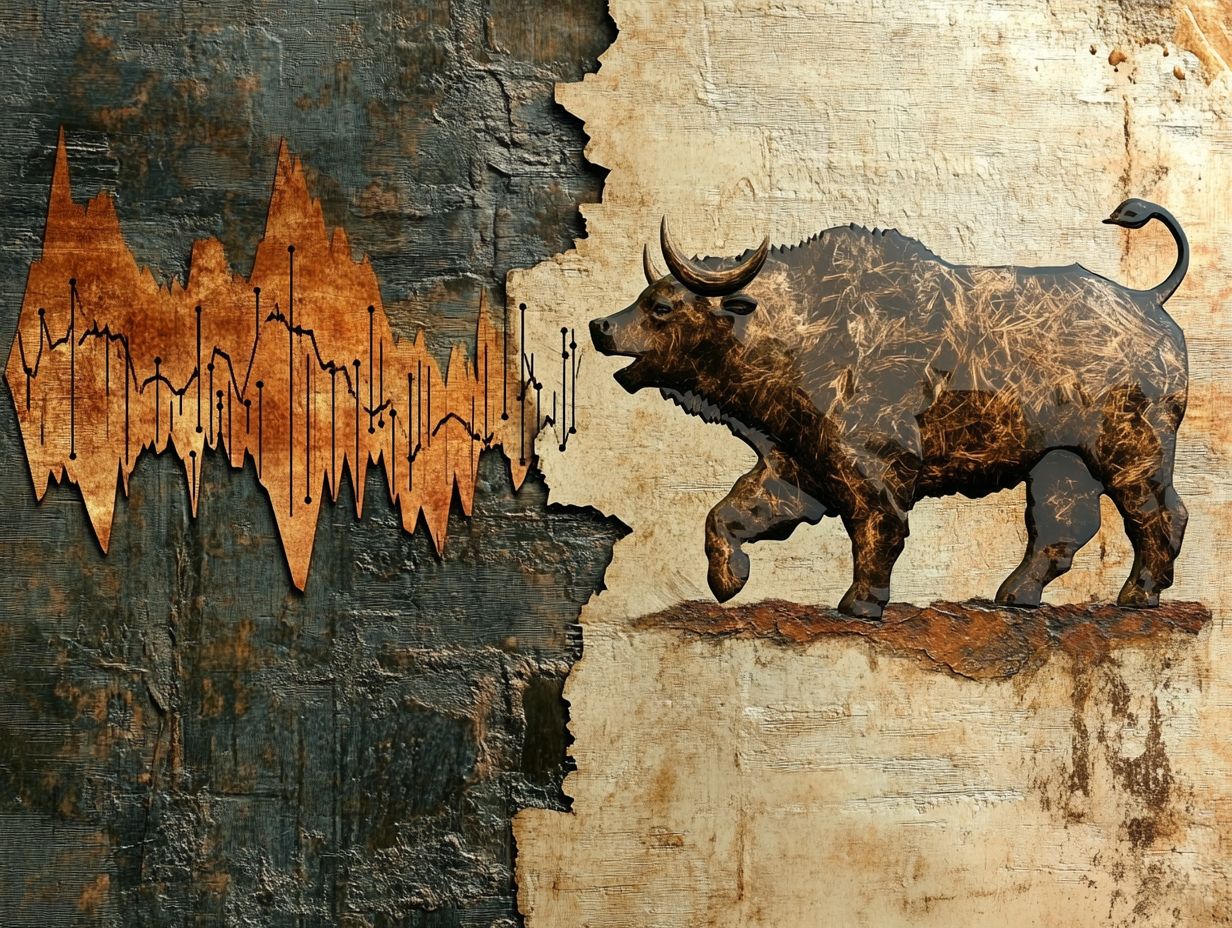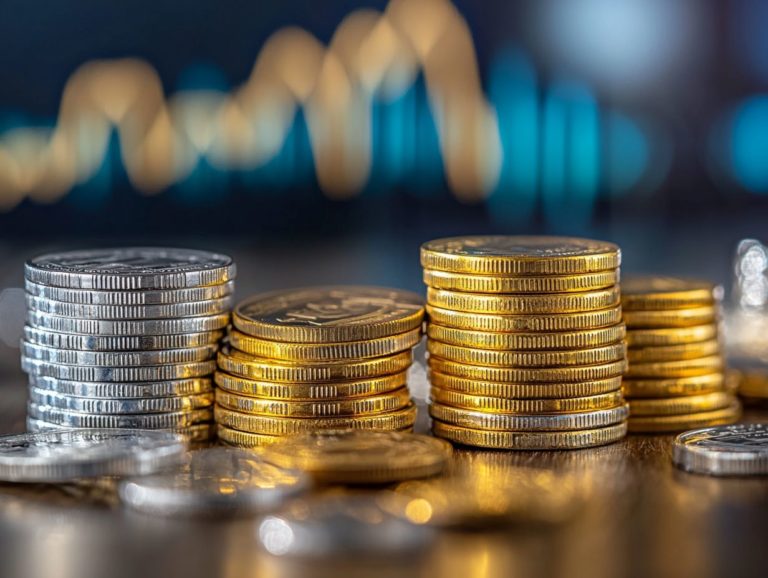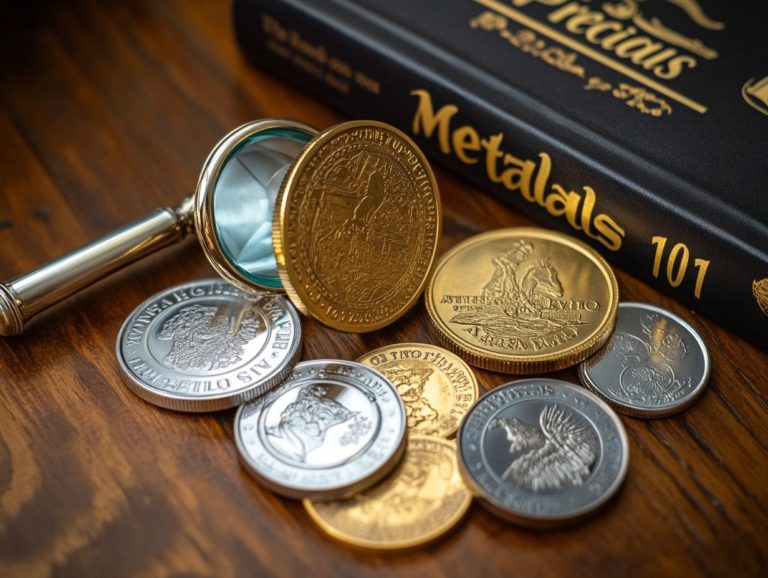How to Identify Bull and Bear Markets in Metals
Navigating the metals market can be an exhilarating yet intimidating endeavor, especially with constant fluctuations between bull and bear markets.
Understanding the fundamental definitions and characteristics of these market trends is crucial for any savvy investor.
Get ready to explore the factors that shape metals market trends, including economic and political influences, as well as key indicators that signal shifts in the market.
You’ll uncover effective investment strategies tailored for both bull and bear markets, along with practical tips for managing risks.
Jump in now to uncover insights that can transform your investment journey in the metals market!
Contents
Key Takeaways:

- Identify market trends in metals for successful investing.
- Recognize how economic and political influences greatly impact the market, causing fluctuations between bull and bear phases.
- Know key indicators and patterns to determine when to buy and sell metals in different market conditions.
Understanding Bull and Bear Markets
Understanding bull and bear markets is essential as you navigate the financial market. A bull market is when prices are rising, and investor confidence is high, often leading to substantial gains for long-term investors.
Conversely, a bear market is marked by declining prices and economic downturns, posing significant risks and potentially leading to considerable losses for both short-term investors and your investment portfolio.
The shift between these two states typically mirrors broader economic cycles and market indicators, which can be vital in shaping your investment strategies.
Definition and Characteristics
A bull market occurs when stock prices are on the rise, characterized by a wave of investor confidence. In contrast, a bear market signifies falling prices and a pervasive sense of pessimism among investors.
During a bull market, investors are optimistic, leading to increased buying activity and pushing prices higher. The opposite occurs in a bear market, where fear takes hold, resulting in widespread selling and, ultimately, lower prices.
For example, after the 2008 financial crisis, the stock market entered a pronounced bear phase filled with extreme volatility, as economic concerns triggered massive sell-offs. The recovery that followed, along with the surge in stock prices, epitomized a robust bull market.
This scenario vividly demonstrates how investor sentiment can dramatically alter the market landscape.
Factors Affecting Metals Market Trends
The factors influencing metals market trends are diverse and can significantly impact the prices of precious metals like gold and copper.
Economic indicators, geopolitical events, and evolving market conditions are pivotal in driving price fluctuations. For instance, investor behavior, inflation rates, and supply-demand dynamics all work together to shape the intricate landscape of the metals market.
Economic and Political Influences

Economic downturns and geopolitical events profoundly influence the metals market, often leading to shifts in investor confidence and altering market predictions.
When interest rates rise, borrowing costs increase, which can stifle economic growth. This usually results in a decline in demand for industrial metals, negatively impacting their prices. Conversely, during high inflation, investors tend to gravitate toward precious metals like gold and silver, viewing them as safe havens.
Political tensions, such as trade wars or sanctions, can severely disrupt supply chains, complicating availability and pricing.
A notable example is found in aluminum markets during the imposition of tariffs on imports, creating volatility that traders must navigate with precision.
Identifying Bull and Bear Markets in Metals
Identifying bull and bear markets in metals demands a discerning grasp of various market indicators and analysis tools, such as Fibonacci retracement and chart patterns.
These instruments help you evaluate market conditions and forecast price trends with precision. This ultimately enables you to craft informed investment strategies that align with your financial goals.
Key Indicators and Patterns
Key indicators and patterns, such as market behavior and Fibonacci retracement levels, are crucial for identifying shifts between bull and bear markets in precious metals like gold and copper.
These tools provide a roadmap of potential price movements and help you recognize critical reversal points that signal a shift in sentiment. For example, by observing trading volumes during price changes, you can uncover underlying strength or weakness in market trends, which guides your investment decisions.
Utilizing moving averages helps smooth out price fluctuations, offering you clear insights into the overall trend direction.
Understanding these elements is essential for managing your long positions effectively and strategically positioning yourself to maximize returns while minimizing risk.
Strategies for Investing in Bull and Bear Markets
Developing effective investment strategies in both bull and bear markets is essential for you as an investor! Whether you’re focused on the long term or prefer short-term gains, navigating price fluctuations requires a keen understanding of market trends, enabling you to adapt your approach.
During bull markets, you can capitalize on upward trends. In bear markets, take steps to mitigate risks and protect your investments.
How to Take Advantage of Market Trends

To fully capitalize on market trends, remain vigilant and responsive to fluctuations, especially during market recoveries or price surges! Act now to seize opportunities as they arise!
By actively monitoring economic indicators, staying updated on global events, and utilizing advanced analysis tools, you can identify emerging opportunities that align with your investment goals.
Diversifying your portfolio across various asset classes, such as stocks, bonds, and alternative investments, provides stability during unpredictable market cycles.
Employing dollar-cost averaging and regularly rebalancing your allocations builds resilience against market downturns. By being proactive and adaptable, you mitigate risks and position yourself favorably to reap the benefits of future growth trends.
Managing Risks in Metals Market Investing
Effective risk management is vital for your success in metals market investing, especially during market declines or economic downturns when investor confidence may be shaky.
Implementing robust strategies to mitigate risks safeguards your investment portfolio and secures long-term financial stability.
Tips for Mitigating Risks
Mitigating risks in metals market investing requires careful assessment of economic indicators and market behavior to inform your strategic decisions.
By analyzing key economic indicators such as inflation rates, interest rates, and global demand trends you gain insights that significantly influence your investment strategies.
Adjusting your investment portfolio to include a balanced mix of commodities, equities, and safe-haven assets effectively shields you against potential downturns.
Employing techniques like stop-loss orders and diversifying your holdings are essential preventive measures that protect you from market volatility.
Staying informed about geopolitical developments and supply chain disruptions enhances your decision-making process, ensuring your investment strategy remains resilient in the dynamic world of metals trading.
Frequently Asked Questions
For more insights, consider implementing the strategies discussed or seek professional advice to enhance your investment journey!
What is a bull market in metals?

A bull market in metals occurs when metal prices rise and the general market feeling is optimistic. This often happens due to high demand for metals and good economic news.
What is a bear market in metals?
A bear market in metals happens when metal prices fall, and the general market feeling is pessimistic. This usually results from low demand for metals and bad economic news.
How to identify a bull market in metals?
You can spot a bull market by looking for rising prices and strong demand. Good economic conditions will also signal a bull market.
How to identify a bear market in metals?
To identify a bear market, watch for falling prices and weak demand. Bad economic conditions will indicate a bear market.
Common indicators of a bull market in metals
Look for rising prices, increased trading volume, and positive economic growth. These signs indicate a thriving market for metals!
Common indicators of a bear market in metals
Falling prices, decreased trading volume, and negative economic growth are signs of a bear market. These factors make it tough for metals in the market.














